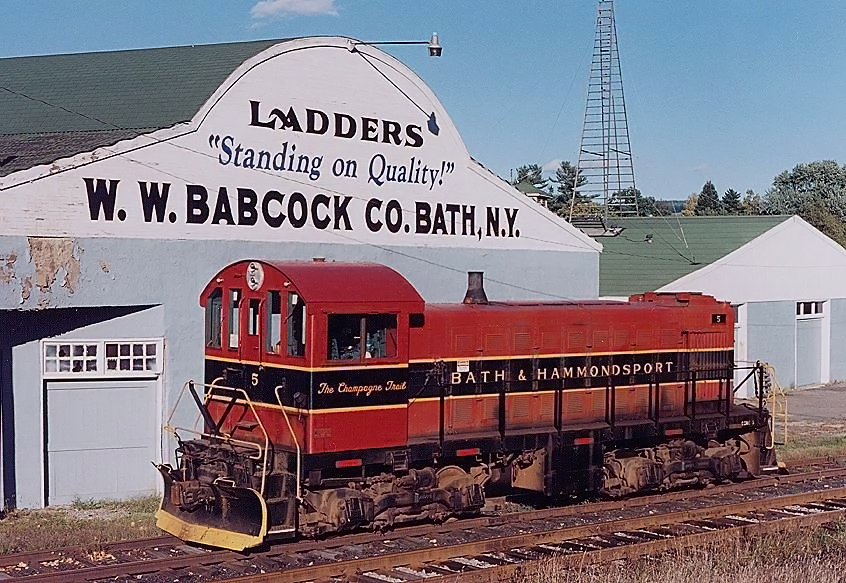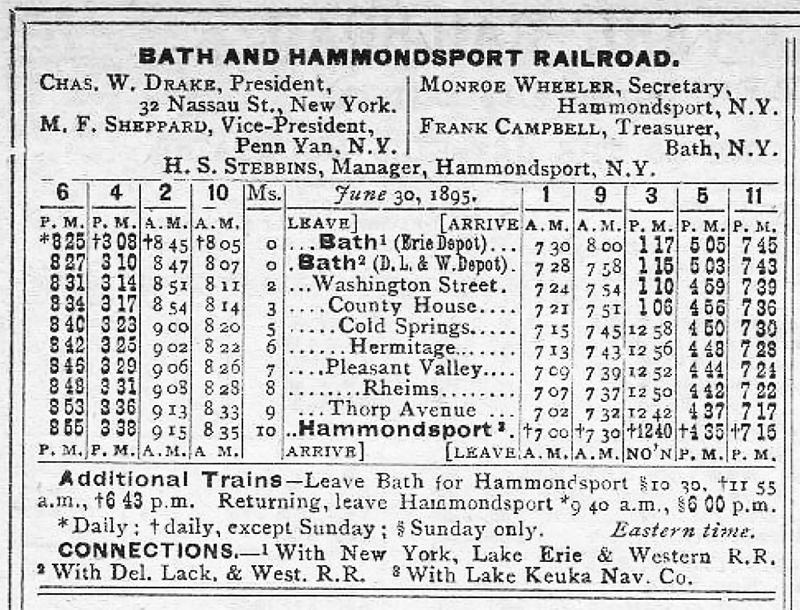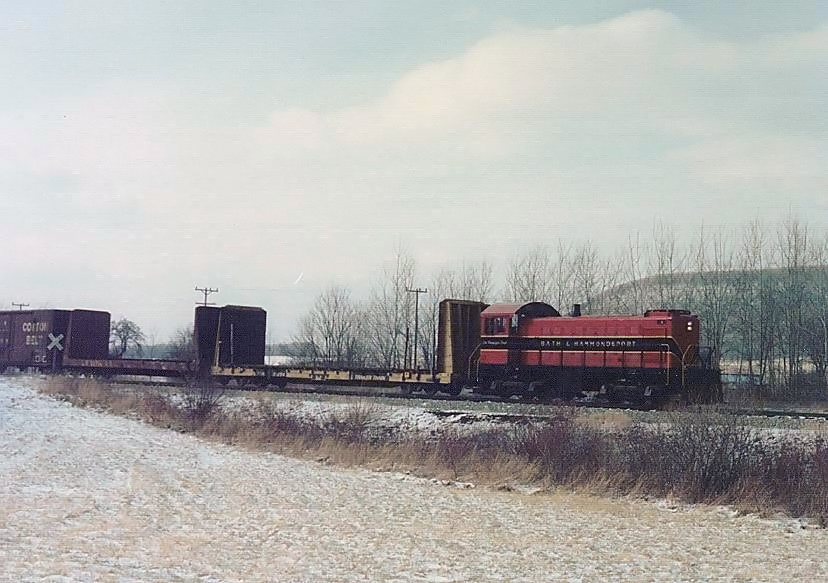B&H Rail Corporation: The Former Bath & Hammondsport
Published: August 2, 2024
By: Adam Burns
B&H Rail Corporation (reporting mark BH), formerly known as the Bath & Hammondsport Railroad, is an historic short line.
For many years it provided essential rail service to the communities of Bath and Hammondsport in New York. The line facilitated critical connections in Bath with the Erie Railroad
Established in 1872, the B&H was initially chartered as a narrow gauge line (3 foot), running from the interchange in Bath to Hammondsport. The railroad served the local wine industry and also transported passengers to Hammondsport where they continued their journey further north via steamboat on Keuka Lake.
The railroad was later converted to the standard gauge (4 feet 8 1⁄2 inches) in 1889. In 1996, the line was leased by the Livonia, Avon and Lakeville Railroad.
Today, much of the B&H trackage currently sits unused although the LA&L maintains ownership of the line to Hammondsport in the event new business ever surfaces.
 Bath & Hammondsport S1 #5 sits in front of the Babcock Ladder Company in Bath, NY on October 2, 1994. Doug Kroll photo.
Bath & Hammondsport S1 #5 sits in front of the Babcock Ladder Company in Bath, NY on October 2, 1994. Doug Kroll photo.Narrow Gauge Beginnings
In his book, "American Narrow Gauge Railroads," author Dr. George Hilton notes the Bath & Hammondsport Railroad was originally chartered by C.D. Champlin and other local business leaders on January 17, 1872.
From the start the line was envisioned as a 3-foot narrow-gauge to link Hammondsport, located at the southern edge of Keuka Lake, with the New York, Lake Erie & Western Railroad's (Erie) Buffalo main line at Bath.
The railroad's charter stipulated the builder's could continue the route due west from Bath to another NYLE&W connection at Hornellsville (Hornell) although this extension was never attempted, likely due to lack of funding.
Grading of the line began in ernest in the summer of 1872 and was completed by the following year. While only 9.5 miles in length the route was not without its difficulty; leaving Bath required a 2.9% grade to the summit at Country House before descending along Cold Creek into Hammondsport.
Champlin ran out of money after grading and laying ties. He attempted to sell the unfinished line to the NYLE&W but the railroad was not interested. It was eventually leased to Allen Wood on December 15, 1874 for 99 years.
The new owner laid 40-pound rail and opened the line for service on June 30, 1875; construction had cost a total of $104,806.62 while equipment costs totaled another $18,187.04.
From the start, the B&H's primary traffic was grapes for the wine trade. It also handled summer vacationers and tourists bound for the steamboats of Wood's Lake Keuka Steam Navigation Company which handled travelers from Hammondsport, northward to Penn Yan.
On November 15, 1886 Henry Stebbins acquired Wood's lease and converted the line to standard gauge in 1889. It reopened for service on August 1st that year.
Ironically, the then-Erie Railroad would acquire control of the property in 1908, retaining control until July 25, 1936 when it converted back to local interests. Throughout this time the B&H handled primarily grapes and other traffic for the region's wineries.
Timetable (1895)

Modern Era
In 1960, the Erie and the Delaware, Lackawanna & Western merged to form the Erie Lackawanna Railway. On April 1, 1976, the EL became part of Conrail. That same year, Conrail sold the DL&W line between Bath and Wayland to the Steuben County Industrial Development Agency. B&H Rail Corporation then became the designated operator of this branch.
The primary freight hauled remained wine and related products, lumber, and general commodities. Notably, the line served the Great Western winery, also known as the Pleasant Valley Wine Company.
The county dubbed the line "The Champagne Route," and passenger excursions were conducted under the Champagne Railroad (CGNE). These excursions added a unique charm to the region until they ceased in 1994.
Subsequently, much of the track extending to Hammondsport was taken out of service once wine shipments from that point ended. However, service continued between Bath and Wayland on the former EL track. Freight interchanges remained active with Conrail at Bath, ensuring the line’s role in regional commerce and industry was maintained.
Diesel Roster
| Road Number | Model | Builder | Serial Number | Completion Date | Heritage |
|---|---|---|---|---|---|
| 4 | S1 | Alco | 78139 | 6/50 | ex-N&W #2085; built as Nickel Plate Road #85. |
| 5 | S-1 | Alco | 77077 | 3/50 | ex-Despatch Shops #5; built as NYC #872. |
| 416 | RS18u | MLW | 82255 | 4/1958 | ex-Owego & Harford #1811; ex-CP RS18u #1811; built as CP Rail RS18 #8761. |
| 421 | C424M | Alco | 3367-3 | 10/1963 | ex-Guilford #452; ex-D&H #452; ex-Conrail #2495; built as Reading C424 #5206. |
| 422 | C424M | 3358-14 | Alco | 6/1963 | ex-LA&L #422; ex-Guilford #451; ex-Maine Central #451; ex-Springfield Terminal #74; ex-Conrail #2488; built as Erie Lackawanna #2414. |
 Bath & Hammondsport S1 #4 works a short freight a few miles south of Wayland, New York on the ex-DL&W mainline on November 24, 1976, their first year of operation of this line, which more than doubled the size of the railroad. Doug Kroll photo.
Bath & Hammondsport S1 #4 works a short freight a few miles south of Wayland, New York on the ex-DL&W mainline on November 24, 1976, their first year of operation of this line, which more than doubled the size of the railroad. Doug Kroll photo.Livonia, Avon and Lakeville Acquisition
In May 1996, the Livonia, Avon and Lakeville Railroad (L&AL) took over operations of the county-owned trackage, including the original B&H line. These operations were transitioned to the subsidiary Cohocton Valley Railroad in 2001, which was subsequently rebranded as B&H Rail Corporation and then secured a long-term lease for Norfolk Southern trackage running between Wayland, Bath, and Painted Post. At that time, L&AL initiated an extensive track rehabilitation program, replacing numerous ties to enhance the line's infrastructure.
While the track to Hammondsport remains out of service, it has not been abandoned. As of August 2008, B&H Rail Corporation has been operating regular rail services between Cohocton and Painted Post.
Approximately half a mile of the Hammondsport branch is being utilized as a siding, and the original line, designated as the Hammondsport Running Track, is maintained for potential future service.
New construction efforts have also been evident on the stretch from Bath to Painted Post, where dirt embankments have been prepared for potential additional sidings.
The railroad’s main office and locomotive maintenance facility are based in Cohocton. Further, in 2012, a second engine house was constructed in Coopers Plains, indicating continued investment in the region's rail infrastructure.
Recent Articles
-
New Mexico Railroad Museums: A Complete Guide
Apr 23, 25 02:25 PM
The enchanting state of New Mexico, known for its vivid landscapes and rich cultural heritage, is home to a number of fascinating railroad museums. -
New Hampshire Railroad Museums: A Complete Guide
Apr 23, 25 02:11 PM
New Hampshire, known for its breathtaking landscapes, historic towns, and vibrant culture, also boasts a rich railroad history that has been meticulously preserved and celebrated across various museum… -
Minnesota Railroad Museums: A Complete Guide
Apr 22, 25 12:17 PM
The state of Minnesota has always played an important role with the railroad industry, from major cities to agriculture. Today, several museums can be found throughout the state.